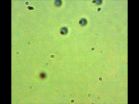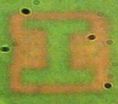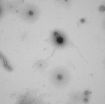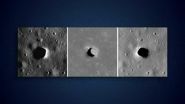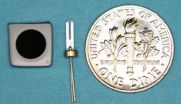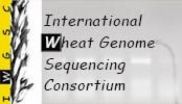(Press-News.org) VIDEO:
This is a video demonstrating scanning-stage-based exposure, whereby programmed
motion of a microscope stage is used to write the University's "Block I " logo into the plasmonic film. Each bar in the...
Click here for more information.
Researchers at the University of Illinois at Urbana-Champaign have demonstrated that an array of novel gold, pillar-bowtie nanoantennas (pBNAs) can be used like traditional photographic film to record light for distances that are much smaller than the wavelength of light (for example, distances less than ~600 nm for red light). A standard optical microscope acts as a "nanocamera" whereas the pBNAs are the analogous film.
"Unlike conventional photographic film, the effect (writing and curing) is seen in real time," explained Kimani Toussaint, an associate professor of mechanical science and engineering, who led the research. "We have demonstrated that this multifunctional plasmonic film can be used to create optofluidic channels without walls. Because simple diode lasers and low-input power densities are sufficient to record near-field optical information in the pBNAs, this increases the potential for optical data storage applications using off-the-shelf, low-cost, read-write laser systems."
"Particle manipulation is the proof-of-principle application," stated Brian Roxworthy, first author of the group's paper, "Multifunctional Plasmonic Film for Recording Near-Field Optical Intensity," published in the journal, Nano Letters.
"Specifically, the trajectory of trapped particles in solution is controlled by the pattern written into the pBNAs. This is equivalent to creating channels on the surface for particle guiding except that these channels do not have physical walls (in contrast to those optofluidics systems where physical channels are fabricated in materials such as PDMS)."
To prove their findings, the team demonstrated various written patterns—including the University's "Block I" logo and brief animation of a stick figure walking—that were either holographically transferred to the pBNAs or laser-written using steering mirrors.
"We wanted to show the analogy between what we have made and traditional photographic film," Toussaint added. "There's a certain cool factor with this. However, we know that we're just scratching the surface since the use of plasmonic film for data storage at very small scales is just one application. Our pBNAs allow us to do so much more, which we're currently exploring."
The researchers noted that the fundamental bit size is currently set by the spacing of the antennas at 425-nm. However, the pixel density of the film can be straightforwardly reduced by fabricating smaller array spacing and a smaller antenna size, as well as using a more tightly focusing lens for recording.
"For a standard Blu-ray/DVD disc size, that amounts to a total of 28.6 gigabites per disk," Roxworthy added. "With modifications to array spacing and antenna features, it's feasible that this value can be scaled to greater than 75 gigabites per disk. Not to mention, it can be used for other exciting photonic applications, such as lab-on-chip nanotweezers or sensing."
"In our new technique, we use controlled heating via laser illumination of the nanoantennas to change the plasmonic response instantaneously, which shows an innovative but easy way to fabricate spatially changing plasmonic structures and thus opens a new avenue in the field of nanotech-based biomedical technologies and nano optics," said Abdul Bhuiya, a co-author and member of the research team.
INFORMATION:
In addition to Bhuiya and Roxworthy, who earned his PhD in electrical and computer engineering at Illinois and is now a National Research Council postdoctoral researcher at the National Institute of Standards and Technology (NIST), the research team includes postdoctoral researchers V. V. Gopala K. Inavalli and Hao Chen. All are members of Toussaint's Laboratory for Photonics Research of Bio/nano Environments (PROBE) at Illinois.
'Nanocamera' takes pictures at distances smaller than light's own wavelength
How is it possible to record optically encoded information for distances smaller than the wavelength of light?
2014-07-17
ELSE PRESS RELEASES FROM THIS DATE:
Tiniest catch: University of Arizona scientists' fishing expedition reveals viral diversity in the sea
2014-07-17
A fishing expedition of microscopic proportions led by University of Arizona ecologists revealed that the lines between virus types in nature are less blurred than previously thought.
Using lab-cultured bacteria as "bait," a team of scientists led by Matthew Sullivan has sequenced complete and partial genomes of about 10 million viruses from an ocean water sample in a single experiment.
The study, published online on July 14 by the journal Nature, revealed that the genomes of viruses in natural ecosystems fall into more distinct categories than previously thought. This ...
Lunar pits could shelter astronauts, reveal details of how 'man in the moon' formed
2014-07-17
VIDEO:
This video shows images from NASA's LRO spacecraft of various lunar pits.
Click here for more information.
While the moon's surface is battered by millions of craters, it also has over 200 holes – steep-walled pits that in some cases might lead to caves that future astronauts could explore and use for shelter, according to new observations from NASA's Lunar Reconnaissance Orbiter (LRO) spacecraft.
The pits range in size from about 5 meters (~5 yards) across to more than ...
Older adults who walk out of necessity are at highest risk for outdoor falls
2014-07-17
Older adults are at a greater danger of falling when walking for utilitarian purposes such as shopping and appointments than when walking for recreation, according to a study from UMass Medical School.
"Older adults have two times the risk of falling while walking out of necessity than walking for recreation, and four times greater risk of injury from a fall on a sidewalk than in a recreational area," said Wenjun Li, PhD, associate professor of medicine in the Division of Preventive and Behavioral Health at UMMS and lead author of the study "Utilitarian Walking, Neighborhood ...
Estimating earthquake frequency and patterns in the Puget Lowland
2014-07-17
Boulder, Colo. - The hazard posed by large earthquakes is difficult to estimate because they often occur hundreds to thousands of years apart. Because written records for the Puget Lowland of northwestern Washington cover less than 170 years, the size and frequency of the largest and oldest earthquakes on the Seattle and Tacoma faults are unknown. Past earthquakes can only be estimated through geologic studies of sediments and landforms that are created when faults break the ground surface.
Along the Cascadia margin, the cities of Seattle and Tacoma occupy the Puget ...
Discovery may make it easier to develop life-saving stem cells
2014-07-17
Not unlike looking for the proverbial needle in a haystack, a team of Michigan State University researchers have found a gene that could be key to the development of stem cells – cells that can potentially save millions of lives by morphing into practically any cell in the body.
The gene, known as ASF1A, was not discovered by the team. However, it is at least one of the genes responsible for the mechanism of cellular reprogramming, a phenomenon that can turn one cell type into another, which is key to the making of stem cells.
In a paper published in the journal Science, ...
Losing sleep over your divorce? Your blood pressure could suffer
2014-07-17
Those who experience persistent sleep problems after a divorce stand to suffer from more than just dark circles. They might also be at risk for potentially harmful increases in blood pressure, a new study finds.
A growing body of research links divorce to significant negative health effects and even early death, yet few studies have looked at why that connection may exist.
Divorce-related sleep troubles may be partly to blame, suggest the authors of a new study to be published in a forthcoming issue of the journal Health Psychology.
"In the initial few months after ...
Choosing cheese
2014-07-17
Go ahead and call Rachel Dutton's research cheesy if you must. As far as she's concerned, it's anything but an insult.
A Bauer Fellow at the Faculty of Arts and Sciences' Center for Systems Biology, Dutton and her lab study cheese – or more precisely – the bacteria and fungi that live on cheese, in an effort to better understand how microbial communities form.
After studying 137 varieties of cheese collected in 10 different countries, Dutton has been able to identify three general types of microbial communities that live on cheese, opening the door to using each as ...
Future electronics may depend on lasers, not quartz
2014-07-17
Nearly all electronics require devices called oscillators that create precise frequencies—frequencies used to keep time in wristwatches or to transmit reliable signals to radios. For nearly 100 years, these oscillators have relied upon quartz crystals to provide a frequency reference, much like a tuning fork is used as a reference to tune a piano. However, future high-end navigation systems, radar systems, and even possibly tomorrow's consumer electronics will require references beyond the performance of quartz.
Now, researchers in the laboratory of Kerry Vahala, the ...
Exploiting gastric vulnerability
2014-07-17
Helicobacter pylori infection promotes stomach ulcers and cancer. How H. pylori initially interacts with and irritates gastric tissue is not well understood. An article published on July 17th in PLOS Pathogens now describes that H. pylori rapidly identifies and colonizes sites of minor injuries in the stomach, almost immediately interferes with healing at those injury sites, and so promotes sustained gastric damage.
Smoking, alcohol, excessive salt intake, and non-steroidal anti-inflammatory drugs cause damage to the tissue lining the stomach, and are associated with ...
Genetic blueprint of bread wheat genome unveiled
2014-07-17
This news release is available in French, Japanese, and German.
The genetic blueprint is an invaluable resource to plant science researchers and breeders. For the first time, they have at their disposal a set of tools enabling them to rapidly locate specific genes on individual wheat chromosomes throughout the genome. Jorge Dubcovsky, Professor at the University of California Davis, USA, says that these results "have been a fantastic resource for our laboratory. The development of genome specific primers, which used to take several weeks of work, can now be done ...
LAST 30 PRESS RELEASES:
Weaving secondary battery electrodes with fibers and tying them like ropes for both durability and performance
Using social media may impair children’s attention
Science briefing: An update on GLP-1 drugs for obesity
Lower doses of immunotherapy for skin cancer give better results
Why didn’t the senior citizen cross the road? Slower crossings may help people with reduced mobility
ASH 2025: Study suggests that a virtual program focusing on diet and exercise can help reduce side effects of lymphoma treatment
A sound defense: Noisy pupae puff away potential predators
Azacitidine–venetoclax combination outperforms standard care in acute myeloid leukemia patients eligible for intensive chemotherapy
Adding epcoritamab to standard second-line therapy improves follicular lymphoma outcomes
New findings support a chemo-free approach for treating Ph+ ALL
Non-covalent btki pirtobrutinib shows promise as frontline therapy for CLL/SLL
University of Cincinnati experts present research at annual hematology event
ASH 2025: Antibody therapy eradicates traces of multiple myeloma in preliminary trial
ASH 2025: AI uncovers how DNA architecture failures trigger blood cancer
ASH 2025: New study shows that patients can safely receive stem cell transplants from mismatched, unrelated donors
Protective regimen allows successful stem cell transplant even without close genetic match between donor and recipient
Continuous and fixed-duration treatments result in similar outcomes for CLL
Measurable residual disease shows strong potential as an early indicator of survival in patients with acute myeloid leukemia
Chemotherapy and radiation are comparable as pre-transplant conditioning for patients with b-acute lymphoblastic leukemia who have no measurable residual disease
Roughly one-third of families with children being treated for leukemia struggle to pay living expenses
Quality improvement project results in increased screening and treatment for iron deficiency in pregnancy
IV iron improves survival, increases hemoglobin in hospitalized patients with iron-deficiency anemia and an acute infection
Black patients with acute myeloid leukemia are younger at diagnosis and experience poorer survival outcomes than White patients
Emergency departments fall short on delivering timely treatment for sickle cell pain
Study shows no clear evidence of harm from hydroxyurea use during pregnancy
Long-term outlook is positive for most after hematopoietic cell transplant for sickle cell disease
Study offers real-world data on commercial implementation of gene therapies for sickle cell disease and beta thalassemia
Early results suggest exa-cel gene therapy works well in children
NTIDE: Disability employment holds steady after data hiatus
Social lives of viruses affect antiviral resistance
[Press-News.org] 'Nanocamera' takes pictures at distances smaller than light's own wavelengthHow is it possible to record optically encoded information for distances smaller than the wavelength of light?
